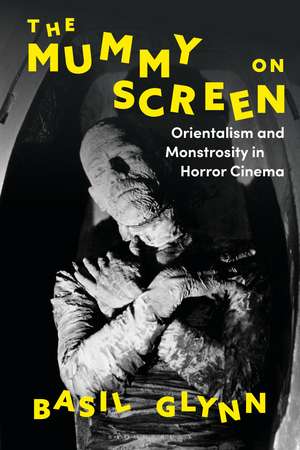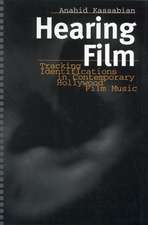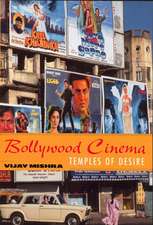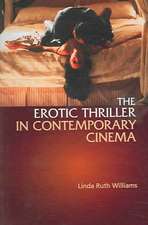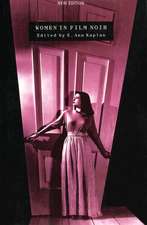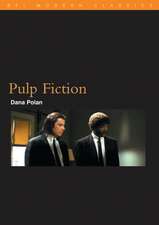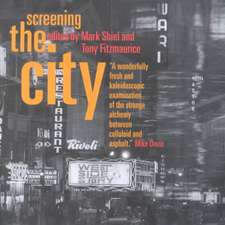The Mummy on Screen: Orientalism and Monstrosity in Horror Cinema
Autor Dr Basil Glynnen Limba Engleză Hardback – 27 noi 2019
| Toate formatele și edițiile | Preț | Express |
|---|---|---|
| Paperback (1) | 216.79 lei 6-8 săpt. | +69.32 lei 6-12 zile |
| Bloomsbury Publishing – 16 iun 2021 | 216.79 lei 6-8 săpt. | +69.32 lei 6-12 zile |
| Hardback (1) | 657.70 lei 3-5 săpt. | |
| Bloomsbury Publishing – 27 noi 2019 | 657.70 lei 3-5 săpt. |
Preț: 657.70 lei
Preț vechi: 943.82 lei
-30% Nou
Puncte Express: 987
Preț estimativ în valută:
125.85€ • 131.40$ • 104.16£
125.85€ • 131.40$ • 104.16£
Carte disponibilă
Livrare economică 14-28 martie
Preluare comenzi: 021 569.72.76
Specificații
ISBN-13: 9781788314084
ISBN-10: 1788314085
Pagini: 216
Ilustrații: 15 bw illus
Dimensiuni: 156 x 234 mm
Greutate: 0.57 kg
Editura: Bloomsbury Publishing
Colecția Bloomsbury Academic
Locul publicării:London, United Kingdom
ISBN-10: 1788314085
Pagini: 216
Ilustrații: 15 bw illus
Dimensiuni: 156 x 234 mm
Greutate: 0.57 kg
Editura: Bloomsbury Publishing
Colecția Bloomsbury Academic
Locul publicării:London, United Kingdom
Notă biografică
Basil Glynn is Senior Lecturer in Film and Television at Middlesex University, UK. His publications have explored a variety of film and television topics, notably television body horror and Asian transnational drama. He is the co-editor of the collection Television, Sex and Society: Analysing Contemporary Representations (Bloomsbury, 2012).
Cuprins
AcknowledgementsAuthor's Notes Introduction:Death is Only the Beginning: Unravelling the Mummy on Screen Section 1: The Mummy in the West and Western Cinema 1. The Creature's Features: Moulding the Mummy and the Mummy Movie The Oriental Mummy as Western Projection The Mummy Genre: Interest and Disinterest 2.The Mutating Mummy: From Ancient Artefact to Modern Attraction Mummy Medicine: An Egyptian Prescription The Mummy as Memento: A Collectible Corpse The Mummy as Public Attraction: Exhumed, Examined and Exhibited Section II: The Mummy in Literature, on Stage and the Silent Screen 3.On the Page and Stage: The Mummy Movie's Literary and Theatrical Influences The Mummy's Tome: A Body of Literature The Rediscovery of Ancient Egypt: A Pharaoh to Remember The Mummy's Literary Life: Electrifying Tales! Romance and the Mummy: Amorous Archaeologists and Comely Corpses Literature's Monstrous Mummies: Dread, Despair and Doyle The Empire Strikes Back: Stoker's Au Revoir to the Voyeur Archaeologist Playing Dead: The Mummy in the Theatre 4. Preserved on Film: The Silent Mummy of Early Cinema Egypt and the Cinema: Monoliths, Mesmerism and Mummies The 'Mummy Complex' and the Preservative Nature of Film The First On-Screen Mummies: Short-lived Moments of Horror in the Trick FilmWinding People Up: Pretend Mummies and Mummy Mix-ups in Silent Comedies Mummy Dearest: The Mummy as Romantic Character Tomb Raiders: Egypt and Early Horror Teutonic Terrors: The First Mummy Horror Movies Grave Danger: Tutmania, the Curse and the Death of the Silent Mummy Section III: Universal Studios and the Mummy of the 1930s and 1940s 5. The Mummy (1932): Overcoming the Silent Treatment 'The Mummy:' Art Horror or Production Line Horror? The Delicate Horror of 'The Mummy:' A Shudder not a Shriek! A Dichotomized Damsel: A 1920s/1930s Eastern/Western Woman A Real Lady-Killer: "The Mummy" as Gothic Romance The Mummy and the Nubian: Yellow Peril and Black Brute 6. The 1940s Mummy Film: A Decade of Decay The Mummy Returns: The 1940s Mummy as Cadaverous Copy More than the Sum of Its Parts: Innovation and the 1940s Mummy 'The Mummy's Hand' (1940): Reinventing the Mummy 'The Mummy's Tomb' (1942): A Memorably Murderous Mummy Lon Chaney Jr.: Cursing the Mummy! The Mummy in America: Fear and Roaming in New England "The Mummy's Ghost (1944):" Escaping Bandaged Bondage "The Mummy's Curse (1944):" The Female Mummy Returns The Demise and Rise of the Mummy: To Buffoon and Back Again Section IV. Hammer Studios and Beyond: The Mummy of the 1950s-Present 7. Hammer's Resurrection of the Mummy: Sex and Digs and Wrap and Roll Show Me the Mummy: Realism with Restraint in 'The Mummy' Culture Clash: The Mummy's Case and the Aftermath of Suez 8. Wrapping up the Mummy: The Last 60 Years Bibliography
Recenzii
The mummy has long been neglected in horror criticism as a stiff and lifeless movie monster. But The Mummy on Screen finds a beating heart beneath the bandages. With exhaustive research and deft analysis, Basil Glynn lifts the shroud on the mummy and finds a fascinating and malleable monster whose mute body nonetheless speaks volumes about the Orientalist imagination.
If the Mummy has enjoyed considerably less critical attention or regard than its fellow movie undead, Basil Glynn rectifies that neglect in this persuasive reappraisal, tracing the beat of the cloth-wrapped feet in an authoritative and illuminating study of an enduring and deceptively versatile movie monster.
Glynn not only shows us the origins of the shambling terror . he takes us on an intellectually thrilling tour of the orientalist assumptions western audiences bring to the fictional mummy. Glynn will make you wonder why you ever cared so much about zombies and vampires in this accessible and brilliant examination of a truly terrifying monster that, until now, has never been given its due. Beware the mummy's curse! But read this book anyway.
Glynn's observation that the Mummy has 'stalked . . . its way through the movies, largely unappreciated by critics, academics and cultural commentators' is an astute, if unfortunate one. Just as the Mummy is often without voice in the cinema, the same may largely be said of its presence in academic literature. Glynn's book isn't just welcome: it's essential. The Mummy, as Glynn points out, is perhaps the cinema's most lucrative yet (paradoxically) unappreciated teratological figure. The Mummy on Screen's legibility and wealth of research will make it indispensably useful. Undergraduate students will love it-graduate students will appreciate its accessibility; professors will wish they had written it.
The time has come to understand and embrace the Mummy's ongoing cultural relevance. Glynn unwraps the archetypal Mummy's relentless trajectory from ancient artefact to modern attraction!
If the Mummy has enjoyed considerably less critical attention or regard than its fellow movie undead, Basil Glynn rectifies that neglect in this persuasive reappraisal, tracing the beat of the cloth-wrapped feet in an authoritative and illuminating study of an enduring and deceptively versatile movie monster.
Glynn not only shows us the origins of the shambling terror . he takes us on an intellectually thrilling tour of the orientalist assumptions western audiences bring to the fictional mummy. Glynn will make you wonder why you ever cared so much about zombies and vampires in this accessible and brilliant examination of a truly terrifying monster that, until now, has never been given its due. Beware the mummy's curse! But read this book anyway.
Glynn's observation that the Mummy has 'stalked . . . its way through the movies, largely unappreciated by critics, academics and cultural commentators' is an astute, if unfortunate one. Just as the Mummy is often without voice in the cinema, the same may largely be said of its presence in academic literature. Glynn's book isn't just welcome: it's essential. The Mummy, as Glynn points out, is perhaps the cinema's most lucrative yet (paradoxically) unappreciated teratological figure. The Mummy on Screen's legibility and wealth of research will make it indispensably useful. Undergraduate students will love it-graduate students will appreciate its accessibility; professors will wish they had written it.
The time has come to understand and embrace the Mummy's ongoing cultural relevance. Glynn unwraps the archetypal Mummy's relentless trajectory from ancient artefact to modern attraction!
